News in Brief
Mandatory Price Reporting Renewed
The American Sheep Industry Association commends the U.S. House for reauthorizing Mandatory Livestock Price Reporting through 2020.
“We thank the members of the House for passing this important legislation to ensure that the sheep industry has access to market information,” said ASI President Burton Pfliger (N.D.). “Failure to act would have left sheep producers without critical price information at a time of the year when marketing lambs is at its highest.”
The final version of the bill included technical changes to lamb reporting that will result in the capture of more transactions and more accurate reports. The volume threshold for importers and packers to report has been lowered. The bill also mandates that USDA conduct a study, taking input from the livestock and meat community, on the workability of the reporting program before the next reauthorization in 2020.
Mandatory Price Reporting requires meat packers to report to USDA the prices they pay for lamb, cattle and hogs purchased from farmers and ranchers for slaughter, as well as the prices they receive for the sale of wholesale lamb, beef and pork. Mandatory Price Reporting also requires USDA to issue livestock and meat market reports.
Nanjing, China, Wool Conference
ASI Wool Consultant Barry Savage attended the wool conference in Nanjing, China, recently and offered the following thoughts on the trip.
“We have seen a lot of U.S. press releases recently related to the impact that the weakening Chinese economy has had on the U.S. financial markets, and on all markets worldwide. At the Nanjing Wool Market Conference attended by U.S. industry and ASI representatives, the information indicated was that the Chinese economy is expected to remain relatively ‘subdued’ for the near future,” Savage wrote.
“Labor costs have increased significantly in the last two to three years, and the significant Chinese crackdown on industry pollution has also increased production costs significantly. This, along with difficult international trading conditions, has negatively impacted Chinese exports. The Chinese domestic market has also slowed. These two factors are expected to have the Chinese economy grow at a much reduced rate of 6 to 7 percent, versus the much higher double-digit growth rates experienced until recently. As China is a major importer of U.S. wool, these conditions are, in turn expected to slow any significant growth in wool exports to China in the near future.”


